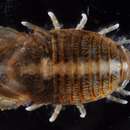en
names in breadcrumbs


"Dana gives the following description : — ' Body nearly smooth, in part very fine granulous and pubescent. Abdomen subtriangular, very tumid, excepting the parts towards the margin around; at extremity a deep fissure, which at its inner end is produced a short distance transversely in either direction. Caudal ajipendages reaching slightly beyond line of abdomen; inner lamella the broader and slightly the longer, broadly rounded at apex ; outer having the outer margin much reflexed.' Then, after stating that the habitat was ' Nassau Bay, Fuegia,' he adds: — ' Length of body, two and a half lines. The fissure in the extremity of the abdomen is of peculiar depth and shape; the part of the surface of the abdomen anterior to its inner extremity is a little raised, independently of the general globose elevation which characterizes the whole segment anterior to this raised point. The minute hairs of the surface and slight granulation are seen with a lens most distinctly on the caudal segment.'
Specimens from the lagoon at Minikoi agree so well with this account that nothing but the difference of size, which in them scarcely exceeds 3 mm., could cause any doubt as to the identity of the species. An examination, however, of what may confidently be regarded as the sexes of one and the same species leads to the conclusion that the aperture in the telsonic segment belongs only to the male. It is probably a character of the adult, since all the smaller specimens as well as the female carrying young are devoid of this transversely rounded opening. Cymodoce cordiforaminalis, Chilton, has the aperture of a rather different shape, but is otherwise a species so similar to the present that it will be interesting to learn whether it exhibits the same sexual difference.
The head has a blunt rostral point between two emarginations. In the male the seventh segment of the peraeon is slightly indented at the middle of the hind margin, which is smoothly convex in the female. The pleon has a very short first segment overlapped by the peraeon. This segment is closely united to a composite segment, probably representing the second to the fifth, the angles of the fourth and fifth being to a certain extent distinct but strongly overlapped by those of the preceding segment.
The eyes are not very large, but prominent, conspicuously faceted. The first antennae have a stout composite basal joint, followed by a third joint not much longer than broad, and much shorter than the first joint of the eight-jointed flagellum, which exceeds the peduncle in length and has sensory filaments on the terminal joints. What is here regarded as the first joint of the flagellum corresponds with the third joint of the peduncle in Chilton's description.
The second antennae are rather longer than the first, the second joint longer than the first or third, the fourth than the second, the fifth than the fourth, but not ' nearly twice as long' as in Chilton's species. The flagellum is nine-jointed.
The mandibles have a strong molar and tridentate cutting edge with accessory plate and spine-row, and three-jointed palp. The inner plate of the first maxillae is tipped with four setae. But none of the mouth-organs appear to offer any very distinctive features except the maxillipeds. These differ in a marked degree from those of Sphaeroma serratum, as also from those of Sphaeroma rugicaiida. Leach, but neither do they fully agree with those that have been described in any of the species of Exosphaeronia or Cymodoce. The fourth joint is considerably longer than the fifth, and each of these is distally expanded on the inner side, but without forming an elongate lobe; the sixth is fully as long as the fifth, but much narrower; it is broader and longer than the seventh, but forms no distal lobe. The armature is feeble, except on the apex of the plate of the second joint.
The anterior limbs of the peraeon are rather robust, the first pair distinguished from the rest by the fifth joint underriding the sixth, its triangular form allowing the fourth and sixth joints to meet on their outer margin. In the more elongated limbs of the last three pairs the fifth joint has its share in the lengthening. In all the limbs the finger has a little hooked spine in advance of the small hooked unguis. The male appendages of the last peraeon-segment are elongate, close together at the base, with their stiliform apices a little divergent.
The male appendage of the second pleopod appears to be of unusual breadth at the base, then tapering to a narrow apex at some distance beyond the plate that carries it. In Sphaeroma rugicmida this appendage is very long and has a somewhat widened rounded apex.
In the uropods the movable outer ramus is serrate almost all along the outer margin as well as on the rounded apex, in the ramus coalesced with the peduncle the serration reaches up the outer margin barely halfway." (Stebbing, 1904)
"Lagoon, Minikoi, along with a specimen of Ligia." (Stebbing, 1904)
"Length 3 mm., by a breadth of 1-5 mm." (Stebbing,1904)
Sphaeroma is a genus of aquatic isopod crustaceans, part of the family Sphaeromatidae.[1]
Sphaeroma is a genus of aquatic isopod crustaceans, part of the family Sphaeromatidae.